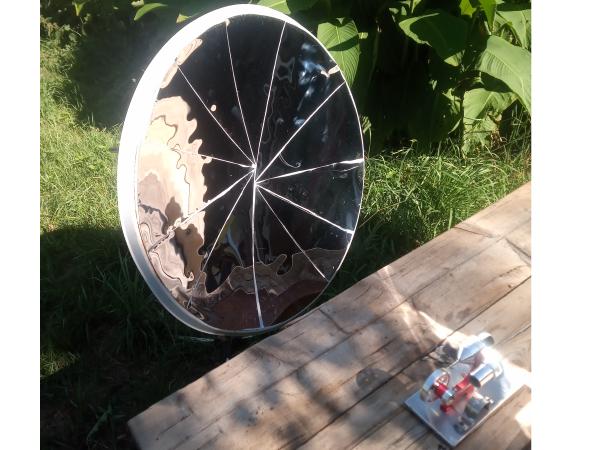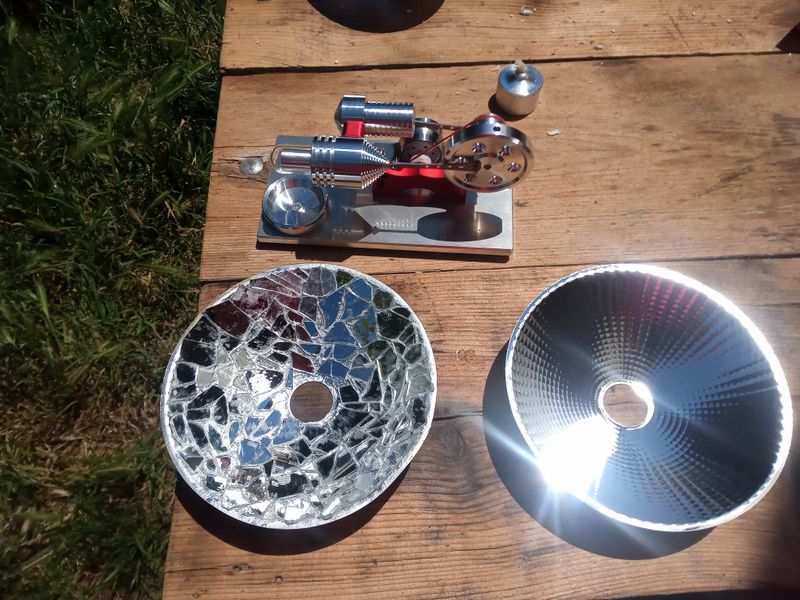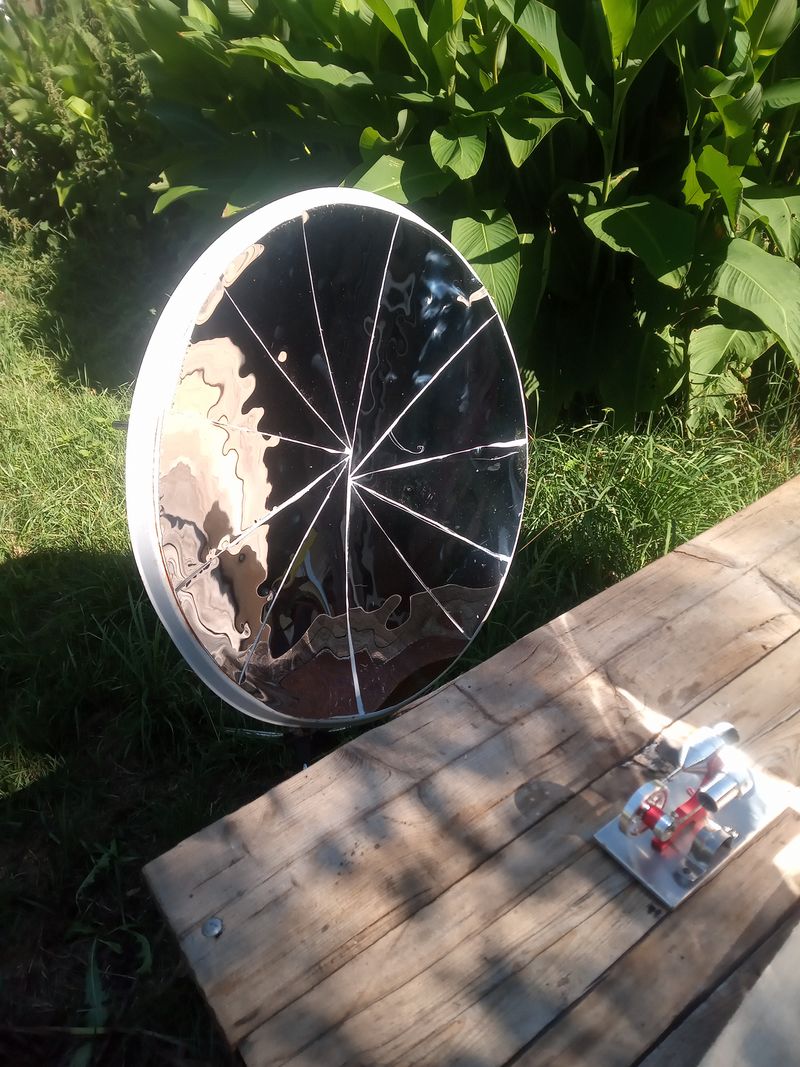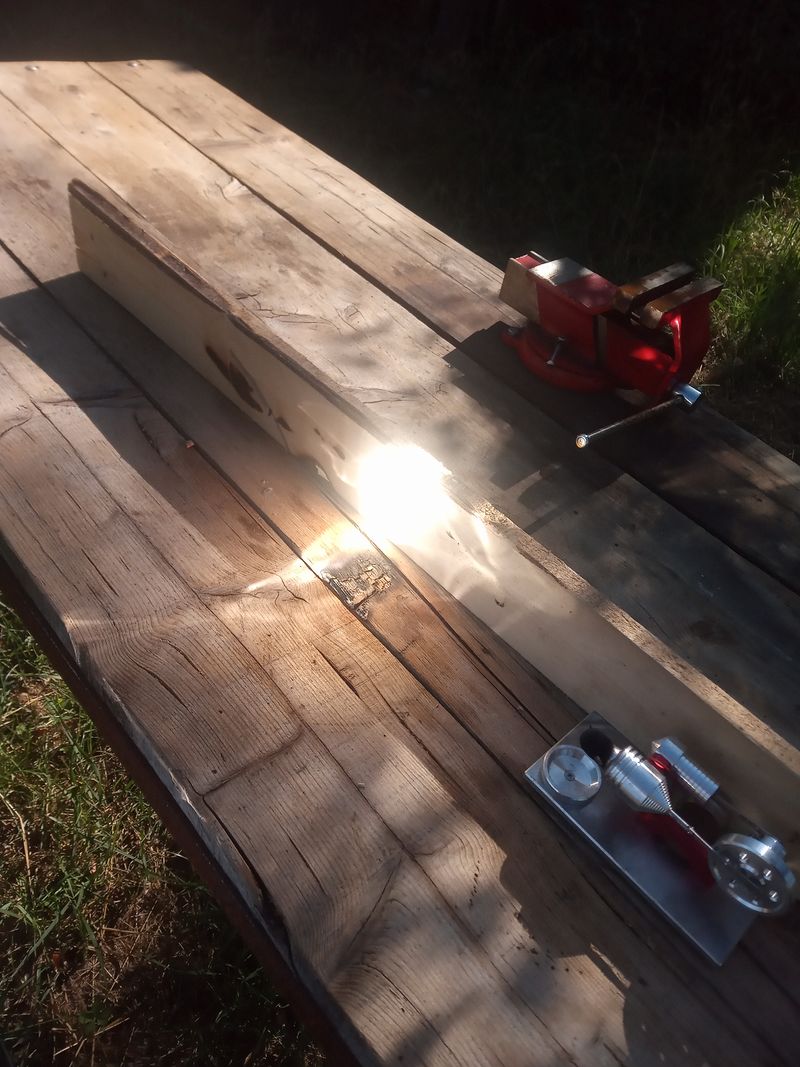Description
Things about stirling engines
Sommaire
Sommaire
Introduction
We now liv in a post-covid world, and wether you're part of
thos who think billionaires tak very seriously climat chang and want
to adress the question with population "regulation" and with survivalists bunkers,
or wether you'r part of those who think billionaires don't car and just want
to keep on getting richer and richer until the last drop of petrol,
it becomes urgent to find alternatives to facism and to the models we are offered,
and it includes technical alternatives.
Stirling engine was invented in the XIX century, before combustion engine
and there are a few "mainstream" industrial uses, in particular in the 60s-70s
(Ford Torino,American ship Caloric).
Also called "hot air engin", its principl is to mov hot air alternatively from 1
cold zon to 1 hot zon and gather the mecanic forc produced by air dilatation (special dedicace Bruno Lemair)
and by air contraction.
High performanc Stirling engines have necessited a lot of research and development and have achieved yields
more performant than combustion engines (around 40%).
They ar reliabl, silent, and hav high yields.
They ar however better adapted to regular regimes.
chronicl of a sleepless night before going handout leaflet against facsism in order to take advantage of the 24h after reception and
befor sabotag of the "toy" I hav received.Étape 1 - web literature review
W hereby list a few videos of diy stirling engine
mor or less diy and in french languag
W can find engin mad with a coca cola can (DDM Brico Voyageur <nowiki>https://www.youtube.com/watch?v=nBxKOkYx2rI), wooden engine
made with glass syringes for the pistons (Incroyables Experiences https://www.youtube.com/watch?v=s79odgWz6BM) , a 125 cm3 manufactured engine with an estimated power of 0,8kW to 8kW (0,6 horsepower to 6 horsepower) considered the measurement of 800 rpm and a tray mass estimated between 100g and 1kg (French Stirling Fablab https://www.youtube.com/watch?v=Z24dZ3St_JE from series https://www.youtube.com/playlist?list=PLE1TyIvCXNyjlvWRi10LUsEMXKyRS6Ltx on channel https://www.youtube.com/@FrenchStirlingFablab)
You can find notably resources to try to build
your own stirling engin that you won't find in th text below
As a bonus, for teachers, 1 example of a tractor and cran toys build in meccano here:
Étape 2 - Toy power
W will now try to measur th power of stirling engin called "scientific toys"
that we can find on aliexpress or on resselers like scienc labs
You will find attached two videos showing 1 stirling engin "scientific toy" that run
with a flam as a heat sourc coming from 1 candl or 1 alcool container combustion.
Th engin comes with 1 small container and a wick that has to be filled with alcool that produc power
adapted to the engine (video 1).
In video with the candl (video 2), the candl flam doesnt produc a power adapted
and the engin only runs for a few seconds and then stops and becomes very capricious to restart (a bit aleatory after
a few tries even after cooldown).
Therefor w measur the power of the two flams (video 3 and 4):
tim to boil 10mL of water from 20°C to 100°C
energy=10*80 cal=800*4,184J=3347,2J
tim for alcool lamp flam: 40s to 1min (wether simmering or boiling)
tim for candl: 90 to 120s
"alcool lamp:"
max_power=3347/40=84W
min_power=3347/60=56W
"candl"
max_power=3347/90=37W
min_power=3347/120=28W
To try to measur yields, we fix a mass to the motor (her a broken nut of 5g in video 5)
and w measur tork traction
and angular speed.
Broken nut mass is 5g and is fixed at a distanc of d=3cm of th rotation axis.
Rotation speed measurement with a 25€ tachymeter this tuesday 25 june 2024: th tachymeter works by friction (rubber traction that turns an axis of which rotation speed is measured): th traction happens after half a second to 1 second and displays values between 100 and 500 rpm and makes th engin stops.
Rotation speed measurement with 1 laser tachymeter (video 5): 1400 rpm with 5g broken nut attached at 3cm of axis
Rotation speed measurement with laser tachymeter for engine 2 (video 6): 1000 to 5000 rpm with 5g broken nut attached at 1,6 cm of the axis
Th yields is low, but w must recall this is a toy and not a engin made for performanc. W could however mak th measurement exercis with high performanc scientific toy (multi cylindres, vertical mover, etc.). Philips stirling engin can hav yields up to 40%.
Étape 3 - Rotation speed verification with video analysis
To measur angular speed, w will us two softwar: 1 python cod sampl based on opencv, and ffmpeg
python commands:
sudo apt install virtualenv
virtualenv --python=/usr/bin/python3 .
source bin/activate
pip3 install opencv-python
import cv2
import os
def charger_images_video(video_filename, output_folder):
"""
Loads video frames from a file and saves each frame as a JPG image.
Args:
video_filename: The path to the video file.
output_folder: The folder where to save JPG images.
Returns:
A NumPy array containing the video images (3D array: frames, rows, cols).
"""
# Open video with OpenCV
cap = cv2.VideoCapture(video_filename)
#Check successful opening
if not cap.isOpened():
print("Erreur d'ouverture du fichier vidéo:", video_filename)
return None
# Check that the output folder exists, if not create it
if not os.path.exists(output_folder):
os.makedirs(output_folder)
# Empty list to store video frames
images_list = []
frame_number = 0
# Play video frames frame by frame
while True:
ret, frame = cap.read()
# Check image playback
if not ret:
break
# Save each frame as a JPG image
frame_filename = os.path.join(output_folder, f'frame_{frame_number:04d}.jpg')
cv2.imwrite(frame_filename, frame)
# Add image to list
images_list.append(frame)
frame_number += 1
# Close video capture
cap.release()
return images_list
# Example of use
video_filename = '00009.MTS'
output_folder = 'frames'
images_list = charger_images_video(video_filename, output_folder)
commands ffmpeg:
sudo apt install ffmpeg ffmpeg -i 00009.MTS -vf fps=25 output_frame_%04d.png
You can reproduc the measurment with the sourc video fil (link here) and the previous sampl code
Unfortunatly at this stag of experienc, the 25fps video doesnt allow to measur correctly
the angular speed of the engin is too fast et makes blurred images on the video broken down in 25 images per second
Unfortunatly the captation at 60fps or more is expensiv (sony camera or zcam at mor than 1000€ on amazon. the advantag is you hav 14 days to test the camera on get reimbursed if it doesnt fit)
w can find 60fps webcam but after a test (Svpro Full HD 1080P Webcam USB Objectif de Mise au Point Manuelle 4 mm, 30fps/60fps/100fps Caméras de Bureau USB CMOS OV2710 pour Linux Windows Android Mac OS, Plug and Play at 33€ on amazon) this wednesday 26 of june captures at 30fps. And you cant really configure video captation software adequately, see this page for exempl wher ther s no parameters to defin fps:
https://wiki.archlinux.org/title/Webcam_setup
test with zcam e2:
video of 60s at 60fps (in theory 3600 frames) with a bit of therebentin (no more alcool 90° confiscated by the cops): the engin runs but visibly slower than when the container is full of 90° alcool. W verify rotation speed.
Strangely, i hav a messag "process stopped" at frame 273 with python script
and ffmpeg does the job and w obtain half a rotation between two consecutive frames, which means 30 rotations per second, which is indeed 1800 rpm
File availabl here if you want to verify:
Étape 4 - Run the engin with a solar sourc
Making a high performanc stirling engin requires a lot of research and development (go! for hackers who want to leak phillips archive of th ford torin - yes 60s and 70s is not only great for music-)
In theory, with a 40% yield, it requires a solar receptor of 2,5m2 (approximatively a receptor of 90cm radius) for a motor of 1kW
w will here scal based on the flam power that runs th engin correctly:
60W to 90W
W will first us 1 small reflector on which we will fix bits of broken mirrors (after a fixation test it is dramatically worse than with the initial surc of the reflector) and measur the tim it takes to hav a small quantity of water boil
and w will make a linear scaling for an adapted diameter (the power of the sun is linear of th sunny surfac)
test this sunny tuesday june 2024
6cm radius reflectors on the photo : the reflecting surface is made of "bumps" not necessarily as good as dedicated surfaces that can be bought for example at solar brother (https://www.solarbrother.com/acheter/reflecteur-solaire-adhesif-s-reflect-500/)
When putting the finger at the center of the reflector at noon and pointing at the sun, w hav a sensation near being burned with a lighter after 5s.
Th test for boiling 3mL of water failed, wether becaus the surface is not smooth enough, wether becaus th container makes too much shadow on the reflecotr, wether becaus the reflector is not well enough oriented to the sun or becaus the container is not well placed at the focal converging point of the sun rays
The sunlight is approximately 1000W/m2, and the surfac of the reflecotr around:
3,14*0,06*0,06=0,0113m2
Th power of the reflector is therfor theorically around: 0,0113*1000=11,3W
To get a power of 90W at noon (w can modulate to lower at another time or when the sunlight is lower), it would require a reflector of radius r:
r=√(90/3,14*1000)=√(90/3140)=√(0,02866242)=0,17m
W would therefor need a piec of spher of around 34cm of diameter
Th satelite antemna (said parabolic) retrieved in a recycling shop is around 60cm diameter, which is way too larg, th surfac being linear to th squar of th radius (in first approximation)
W will therefor buy a parabolic antemna of 40cm diameter (not found lower) and fix a solar reflector tape
Test 12/07 : negative with 40cm parabolic antemna and adhesiv tap: th cylindr of th piston is transparent and the heat of th concentrated sun rays doesnt heaten up well the cylindr. W cant tak to pieces th egin to put steel whool inside lik in stag 1 video. Test tomorrow with tinfoil glued to the cylindr. Otherwis need to find an engin with metal cylindr
Video is bugged and not uploadabl, test again when digital weather is better
negative test of 13/07 noon with tinfoil on cylindr: finetuning the parabolic antemna on the cylindr is difficul, need to be very accurat and with th gear i hav (a mic leg) it requires to suspend the engine in the air, etc.
negativ test of the 16 of july 18h: parabolic antemna of 40cm, concentrated sunlight rays ok, insufficiant solar power
negative test of 23 july 18h: parabolic antemna of 60cm, concentrated sunlight rays too scattered, insufficiant solar power
the concentrated sunlight square is too scattered. It seems it would be appropriate to do a more accurate concentrator (a real sphere piece)
W will try after the holiday to do a spheric concentrator (so with a tinier focal point) with a plaster mould on a sphere like a yoga/kine baloon. If you want to do a tutorial for doing this typ of concentrator, feel free to do so!
Étape 5 - Make and optimize a mobile solar receptor
It is her i pass you the ball
First, w need to think about a receptor that follows the sun dynamically during the day based on its position (th variables ar dat and tim and latitud and longitud)
and mor importantly: that is abl to gather and send sunlight rays concentrated to a fixed point at any time during the day
Then, we can imagin 1 thing based on several receptors of distinct diameters adapted to a varying sunlight
W then hav an infinite sourc of renewable energy, transportabl that will work for a sunlight with a high treshold and a low treshold
W can even imagin 1 society wher machines dont run when the sunlight is not good enough, but this is scienc fiction
To giv some landmarks, the biggest one piece mirrors w ar currently abl to make are telscop mirors of 30m diameter
Telscop mirros of 5m to 10m are more common for big telescop
Im not a specialist, just a populariser concerned with climat chang
and the rise of facism
Therefor and at this tim of my experiment, only two practical aspects are questionning m for an everyday us
to stop the engin (you dont only need to stop injection)
for longer us: keep the cold sourc cold enough and long enough without oversizing th power at hot sourc input (for a performant deltaT)
And becaus at a tim of looming facism rising in many countries, w must stop auto censorship to talk politics when speaking in on own's nam
1 government that would take seriously climat change would have long ago put
stirling engin at exams, encouraged consortiums to work on that,
and created mixed groups of engineers, technicians, diy workers without diplomas from different territories to work on this typ of questions!
Scientific knowledg is contextual of epoch and this is not only in spatial engineering (going on th moon)
w hav lost knowledg. If lobbies prevent from puting again at the agend forgotten techniques,
that are reliabl, it's politic role to create necessary incentiv!
Étape 6 - Your turn
her w are, you hav now web resources to mak your own stirling engin, leads to do research on performant engin builders, a methodology to test and verify rotation speed lower than 3600 rpm in context of digital surveillance and shackle, and ideas for concentrator engin based on dynamic concentrators
For an sun following algorithm, you can hav a look at the cod her:
Dimensionner et faire un tracker solaire photovolatïque low tech
However, a dispositiv based on 4 photoelectric cells and a small maximum seeking electronic circuit driving motors could replace a hard coded algorithm honourably and adapt to all latitudes and longitude without tweaking
I also hav a problem with sabotaged concentrators (scratches, reflector tape taken off) quite quickly, but im sur you will find ways of avoiding that too!
Published




 Français
Français English
English Deutsch
Deutsch Español
Español Italiano
Italiano Português
Português